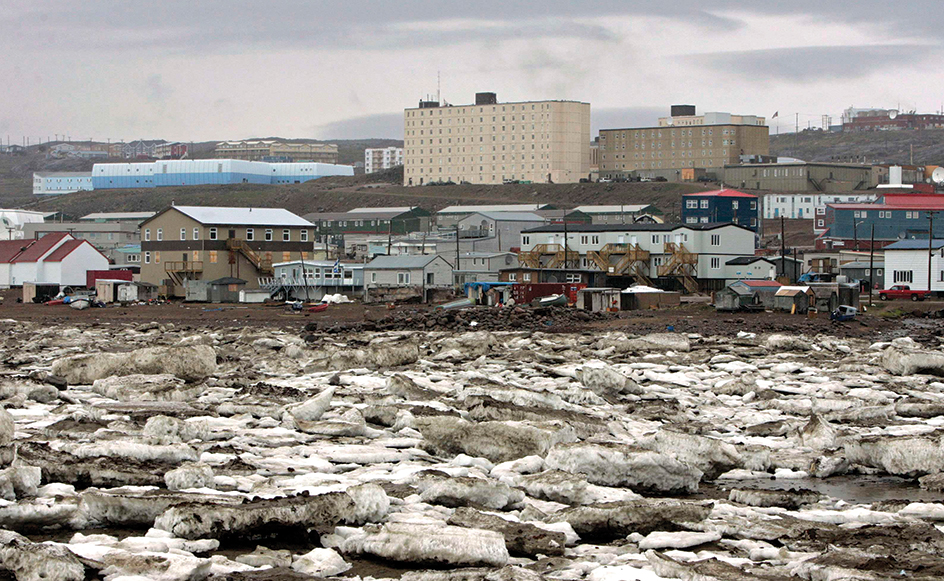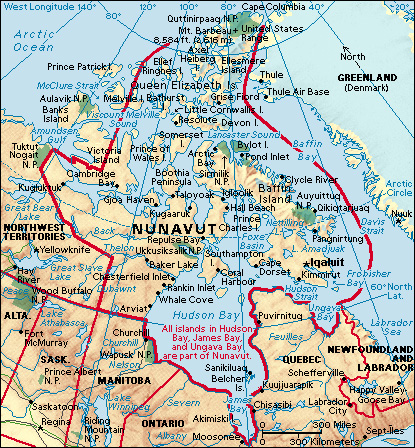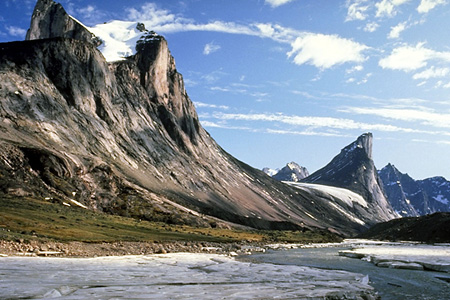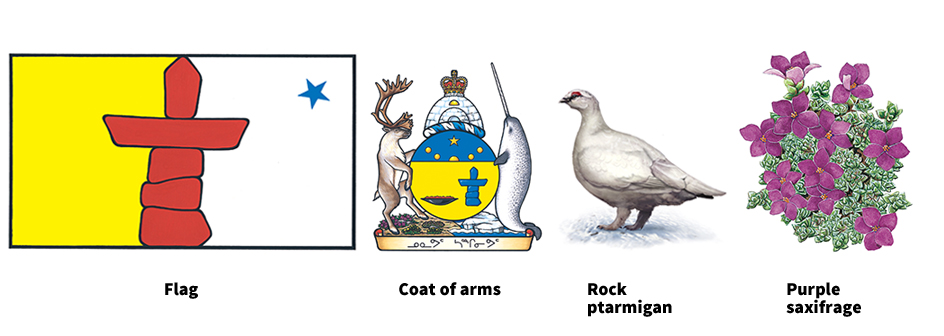Nunavut << NOO nuh voot >> is a Canadian territory located in the northeastern part of the country. It was created from the eastern part of the Northwest Territories in 1999 to provide more self-government for the Inuit, who make up most of the population. Nunavut means Our Land in Inuktitut, an Inuit dialect (language variation). Iqaluit is the capital and largest town.
Nunavut is part of a vast Arctic region that has long, cold winters and short, cool summers. The territory is sparsely populated due to its harsh climate, but it has rich mineral deposits. It covers about 810,000 square miles (2.1 million square kilometers) and makes up about one-fifth of Canada’s land area.
People
Most of Nunavut’s people are Inuit, which means the people in Inuktitut. They live in dozens of small, government-built, mainly coastal communities. Iqaluit, with about 7,400 residents, is the largest populated place. Many of Nunavut’s people play sports, and most hunt or fish for food and as a cultural activity. The territory has three official languages—English, French, and the Inuit language, which includes the Inuktitut and Inuinnaqtun dialects.

Nunavut has a number of social problems, such as high rates of unemployment, suicide, and drug abuse. Nunavut also has a housing shortage, and the people have serious concerns about losing their traditional language and culture.
Land and resources
Location and description.
Much of Nunavut lies north of the Arctic Circle. The territory is bordered on the south by the province of Manitoba, on the west by the Northwest Territories, and on the north by the Arctic Ocean. To the east lies Greenland, a province of Denmark, separated from Nunavut by Baffin Bay and Davis Strait. Many of the islands north of the Canadian mainland are part of Nunavut. The territory’s islands include Baffin, Ellesmere, and Southampton islands, all part of a region known as the Arctic Archipelago. Cape Columbia on Ellesmere Island is Canada’s northernmost point.

Nunavut consists mainly of rocky, rugged, treeless terrain. Much of the ground beneath the surface is permafrost (permanently frozen ground). Some permafrost in Nunavut is more than 2,000 feet (600 meters) thick. Only the top 6 to 60 inches (15 to 150 centimeters) of ground thaws in the summer.
Glaciers cover parts of Baffin and Ellesmere islands, which also have rugged mountains and deep fiords (long, narrow bays). Ellesmere Island has a high mountain range called the United States Range. The range’s highest peak, Mount Barbeau, rises 8,584 feet (2,616 meters) above sea level.
Nunavut is home to a variety of wildlife, including caribou, musk oxen, polar bears, wolves, Arctic foxes, and Arctic hares. Caribou traditionally have been important to the Inuit, providing them with food and clothing. Narwhals and other whales swim in the icy waters of the Arctic Ocean, along with seals and walruses. Ravens, gyrfalcons, and ptarmigan live in Nunavut the year around. Many other birds, such as eider ducks and snowy owls, migrate to the region in the spring. Snow geese nest on Baffin Island. Polynas (areas of open water surrounded by ice) provide for diverse and rich ecosystems in such areas as Lancaster Sound.
Nunavut is rich in mineral resources. It has large deposits of copper, diamonds, gold, iron, lead, nickel, silver, uranium, and zinc. However, many of these resources have not been developed because of the region’s harsh climate and the difficulty of transportation there. As part of a global effort to develop Arctic resources, several companies are exploring for oil and natural gas in the region.
Climate.
Nunavut has long, cold winters and short, cool summers. Average winter temperatures range from about –20 °F (–29 °C) in southern Baffin Island to below –35 °F (–37 °C) on Ellesmere Island. Summer temperatures range from above 50 °F (10 °C) in southern Nunavut to about 36 °F (2 °C) in the north.
Nunavut has a dry climate. Nearly all of the territory receives less than 12 inches (300 millimeters) of precipitation a year. Northern Nunavut gets so little precipitation that it is often considered a polar desert.
Economy
Nunavut does not have a fully developed economy. The harsh climate and terrain hinder access to areas rich in natural resources. The Inuit are making the transition from subsistence hunting (hunting for their own use) and dependence on the government to a wage-earning economy. Training skilled workers and providing secure jobs are a high priority of the government.
The Nunavut government is the largest employer in the territory. Mining is also important to Nunavut’s economy. In 2010, the province began mining gold. The territory has a small, but growing, fishing industry. Char, shrimp, and turbot are the main fishing catches. Hunting and trapping also provide income for some residents.
The spectacular scenery of the region and its rich array of wildlife attract tourists to Nunavut. Inuit organizations and communities offer tourist services. Visitors engage in such activities as exploring, fishing, hiking, hunting, and kayaking. Hearty travelers visit Nunavut’s five national parks—Auyuittuq, Qausuittuq, Quttinirpaaq, Sirmilik, and Ukkusiksalik. 
Arts and crafts have provided income for some Inuit since emerging as an economic sector in the 1950’s and 1960’s. Galleries worldwide sell Inuit soapstone carvings. Prints from Cape Dorset and Pangnirtung are famous. Inuit weavers produce tapestries at weaving centers in Pangnirtung.
Nunavut has few roads and no railroads. Airplanes are the primary means of transportation between Nunavut’s communities. Ships and barges deliver supplies to the communities annually. Many people use snowmobiles. However, traditional dog sled teams still are in common use. Modern telecommunications have helped to overcome problems created by the great distances between communities in Nunavut. All communities have radio and television, transmitted by a satellite relay system. All communities also have telephone service.
Education
All Nunavut communities offer schooling through grade 12. Many schools teach classes in Inuktitut in the lower grades then switch to English instruction in the higher grades. Although Nunavut’s literacy rate is lower than the national rate, an increasing number of students are attending and completing high school.
Nunavut Arctic College provides adult basic education, college and technical courses, and some university programs through partnerships with other institutions. The college has campuses and Community Learning Centres throughout the territory.
The territorial government is working to improve education by reducing class sizes, training and hiring more Inuit teachers, and developing a curriculum focused more on Inuit culture, history, and language. The survival of Inuktitut is a major concern of Nunavut’s government, which also wants the territory’s youth to be able to work in Canada’s largely English-language economy.
Government
Nunavut, along with the Northwest Territories and Yukon, is one of three Canadian territories. The people of Nunavut elect one representative to the Canadian House of Commons. Nunavut also has one representative in the Canadian Senate. Canadian territories have fewer powers than the provinces and require substantial subsidies from the federal government.

A premier heads Nunavut’s government with the assistance of an Executive Council. The Executive Council handles the administration of Nunavut’s government and its relations with the provinces and the federal government.
Nunavut’s Legislative Assembly makes Nunavut’s laws and elects the premier and Executive Council from its membership. Voters elect Assembly members for terms of four years. Nunavut has no political parties. Members of the Assembly are elected as independents. This type of government is called consensus government. It is more in keeping with Indigenous tradition than party politics are.
The territorial government is decentralized, with operations spread across dozens of communities. Hamlet councils carry out local government. However, many hamlets (small communities) lack the resources to attend to local issues.
History
Early history.
Ancestors of the Inuit inhabited the Arctic thousands of years ago. The pre-Dorset culture, the first Canadian Arctic culture, spread eastward from Alaska some 4,000 years ago. About 3,000 years ago, a new culture called the Dorset spread rapidly across the Arctic. The Dorset people adapted well to life in the harsh Arctic climate. They made snow knives from bones and may have been the first people to use the snowhouses called igloos. Stone lamps fueled by animal fat heated their houses.
About 1,000 years ago, another new culture called the Thule << THOO lee >> culture spread across the region, and the Dorset culture disappeared. The Thule people lived in villages. Their houses had stone floors and walls made from whale ribs or boulders covered with turf. Whaling was the cornerstone of their culture. After whaling declined, these people hunted caribou and seals. The importance of villages then declined, and smaller groups lived in seasonal camps of snowhouses and tents. By about 1700, the Thule culture had become the modern Inuit culture.
Arrival of the Europeans.
The Vikings were probably the first Europeans to visit Nunavut. They may have sighted the shores of Nunavut and Greenland about A.D. 1000. About the 1500’s, the riches of China encouraged many explorers to look for a Northwest Passage, a sea route through North America to Asia. Martin Frobisher, an English seaman searching for the Northwest Passage, became the first known European to reach Nunavut. He arrived at Baffin Island in 1576. Frobisher claimed to have discovered gold, but further expeditions showed that he had found iron pyrite, a compound of iron and sulfur known as fool’s gold.
In 1670, King Charles II of England granted part of what later became Nunavut to the Hudson’s Bay Company, a British fur-trading company. The company paid little attention to the area. In 1870, the Dominion of Canada acquired Rupert’s Land and the North-Western Territory, the company’s massive landholdings that included most of what are now northern and western Canada. The Canadian government created Manitoba, Canada’s fifth province, from a small part of the land and organized the remainder as the North-West Territories (later renamed the Northwest Territories).
The Canadian government made part of the North-West Territories into the territory of Yukon in 1898 and cut off additional land to form the provinces of Alberta and Saskatchewan in 1905. In 1912, Manitoba, Ontario, and Quebec acquired certain areas that had belonged to the Territories. The federal government in Ottawa governed the remaining territorial lands, called the Northwest Territories, until 1967.
Development of the modern Canadian North.
The Inuit of the Northwest Territories adapted readily to new economic activity in their region. They participated actively in the whaling industry that operated around Baffin Island and in Hudson Bay in the 1800’s and early 1900’s. They quickly adopted new technologies and proved themselves talented commercial hunters and traders.
Canada’s government played a minimal role in the region until after World War II (1939-1945). It relied on widely scattered Royal Canadian Mounted Police (RCMP) posts, occasional RCMP patrols, and annual visits by supply ships to attend to local concerns.
Conditions changed rapidly during and after World War II. During the war, the United States built several military bases in the Canadian North, including a major airfield at Frobisher Bay (now Iqaluit). Security concerns during the Cold War resulted in the development in the 1950’s of the Distant Early Warning (DEW) line, a series of radar stations across the Arctic. The Cold War was an intense rivalry that developed after World War II between Communist and non-Communist nations.
From the late 1940’s to the 1960’s, the Canadian government sent many Inuit with tuberculosis to hospitals farther south, and many of them died there. The collapse of caribou harvesting and the fur-trade economy caused widespread hardship in the mid-1900’s. As a result, Canada’s government relocated many Inuit to different parts of the Arctic from the mid-1950’s through the early 1960’s. The coming of government housing, modern medical care, residential schools, and welfare payments also brought sweeping change to the Inuit in the mid-1900’s. Residential schools were boarding schools aimed at integrating Indigenous children, including Inuit, First Nations, and Métis children, into mainstream society. Many Inuit who had lived off the land had to adjust to a more settled existence in government-built communities.
Establishment of Nunavut.
For many years, the Inuit of the eastern Northwest Territories had called for their own political unit. They argued that their culture was distinct from other cultures of the Northwest Territories, and that Yellowknife—the capital—was too far away. Yellowknife is near Great Slave Lake, some 1,500 miles (2,400 kilometers) west of Frobisher Bay. Negotiations in the 1970’s and 1980’s between Indigenous organizations and the Canadian government focused on Inuit demands for land, resources, revenues, and self-government. In 1982, the people of the Northwest Territories voted to divide the Territories between east and west.
In 1992, the people of the Northwest Territories approved a boundary to divide the Territories. The new eastern territory would be called Nunavut. In 1993, the Canadian Parliament passed the Nunavut Act, which approved the division of the Northwest Territories and the creation of Nunavut. In 1993, Parliament also passed the Nunavut Land Claims Agreement Act, which gave the Inuit exclusive ownership of nearly one-fifth of Nunavut’s land area, about 135,000 square miles (350,000 square kilometers). Nunavut came into being on April 1, 1999. During its first decade, Nunavut’s government struggled with high expectations, great economic and social challenges, and the various difficulties of addressing Inuit needs.
Global climate change focused attention on Nunavut during the first decade of the 2000’s. Issues included defining the extent of the Arctic continental shelf, the prospects of gas and oil development in the Arctic, control over the Northwest Passage, and the environmental impact of warmer temperatures on Arctic communities.
